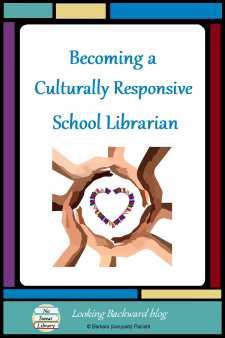 February’s Black History Month is an important national celebration and a busy time for School Librarians. As I read and hear about activities I often wonder:
February’s Black History Month is an important national celebration and a busy time for School Librarians. As I read and hear about activities I often wonder:
- What will School Librarians do about Black History during other months of the school year?
- How will we honor other cultural groups throughout the school year?
We need to consider all aspects of our School Library Program and ask: How can we, as School Librarians, make ourselves, our Library Collection, and our Library Lessons culturally responsive to all students?
OUR OWN CULTURAL ATTITUDES
I believe our school libraries reflect the beliefs and attitudes that we School Librarians have toward others. Our collection development, our library decor, our library lessons, and how we interact with our students reflects that. We must examine our own attitudes carefully: Do we consider someone of a different race, ethnicity, or cultural background with “empathy/sympathy” or with “respect”? They are quite the opposite!
Both empathy and sympathy stem from the Greek ‘pathos’—feeling—and relate to suffering. Both apply to a sharing with another individual; when carelessly associated with groups, it may engender either shame or arrogance about our own background.
Conversely, respect is from the Latin ‘respectus’—looking at—and connotes regard and consideration. It is more encompassing; respect impels us to see the glory in the culture and heritage of others. If we have respect for the culture and heritage of others, then we will choose materials, presentations, and conversations that build positive cultural awareness among our students and teachers.
Be passionate about affirming respect in personal interactions. One year we had a substitute teacher who spent his entire lunch break complaining about “those kids” and their behavior or language or ability. I finally challenged him: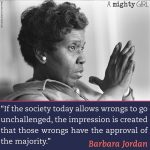 ‘I was tired of hearing him complain about our kids, and if they bothered him so much why didn’t he just quit coming to our building?’ I informed our principal that I had “mouthed off” to the sub, and she was relieved someone had finally spoken up, as were other teachers who heard about it! (thankfully he never returned.)
‘I was tired of hearing him complain about our kids, and if they bothered him so much why didn’t he just quit coming to our building?’ I informed our principal that I had “mouthed off” to the sub, and she was relieved someone had finally spoken up, as were other teachers who heard about it! (thankfully he never returned.)
I’m not promoting myself here. I’m trying to say that we may be inclined to ignore such actions, but supporting any and all of our kids when necessary will ensure that students have an upbuilding educational experience in our libraries and our schools, and that impacts everyone’s future.
OUR LIBRARY COLLECTION
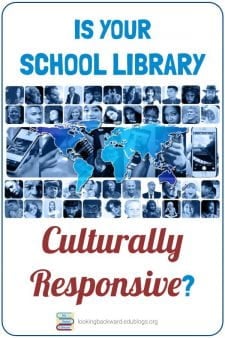 Can your students find themselves in your school library collection? Students can’t develop pride in their culture and heritage if they never read about its positive aspects, and students won’t develop respect for other cultural backgrounds if they only know about their own. Expanding awareness through reading builds pride and respect.
Can your students find themselves in your school library collection? Students can’t develop pride in their culture and heritage if they never read about its positive aspects, and students won’t develop respect for other cultural backgrounds if they only know about their own. Expanding awareness through reading builds pride and respect.
I was fortunate to be the librarian at the most diverse middle school in our district: 33% African-American, 25% Asian, 25% Euro/Anglo, 15% Latinx, and 2% Native Nation. One year our ELL students spoke 30 different languages. I was initially impressed with the collection in the 2-year-old school library, yet later that year a library course on multicultural books helped me discover how few resources we had for 75% of our students:
- A few books on slavery and the Civil Rights Movement, but nothing about African-American culture or other time periods.
- Numerous books on countries, but nothing on Latinx or Asian culture, events, or place in U.S. history.
- Typical food/festivals/folktales books for various cultural groups, but few on other aspects of culture and none on contemporary society or issues, especially emigration/immigration.
- Some reference books but few individual biographies about Black, Latinx, Asian, or Native Nation people.
- A few historical fiction books or award-winners about other cultures/ethnic groups—many by authors who didn’t represent who they were writing about—but meager contemporary realistic Fiction.
Over the years I worked hard to acquire materials that were more representative of our school and that would broaden our students’ perspective on the U.S. and its history: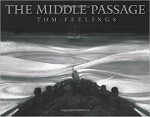
- A more comprehensive view of slavery
- ante-bellum personal narratives & biographies, such as Olaudah Equiano, Frederick Douglass, and Solomon Northrup
- slave resistance and rebellions, and runaway slave communities such as those in Florida and Mexico
- U.S. court cases where slaves prevailed
- Slaves and former slaves who fought, spied, or worked with Union soldiers during the Civil War
- Various cultures, ethnic groups, and time periods in U.S. History
- from the Trail of Tears to the American Indian Movement;
- from early Meso-American settlement to United Farm Workers to contemporary border issues;
- from the Transcontinental Railroad to WWII Internment Camps to Southeast Asian refugees;
- the Harlem Renaissance and African-American roots of contemporary music.

- Contemporary non-fiction about art, music, family life, and other cultural elements over a wide range of ethnicity.
- Individual biographies about Blacks, Latinx, Asians, and Native Nations from ancient to modern times (Eventually encompassing 42% of the biography collection.)
- Historical and Contemporary Realistic Fiction by and about all races, ethnicities, and cultural groups in various situations and locations in the U.S. and other countries
Building a culturally diverse collection is essential, but we must analyze both the quantity and the quality of diverse books on our shelves. Here are a few sources I use for recommendations on quality reading material:
- American Indians in Children’s Literature by Debbie Reese
- Coretta Scott King Book Award
- Pura Belpré Awards
- Mildred L. Batchelder Award
- Arte Publico Press
- Asian/Pacific American Award for Literature
- We Need Diverse Books
- Diverse BookFinder
What books are in your personal library?
Even with authoritative recommendations, I believe we can only choose quality diverse material for our school library if we cultivate a broader view through personal reading about culture and history. I began my own quest in college with 2 books that still reside on my shelf—No More Lies by Dick Gregory and Bury My Heart at Wounded Knee by Dee Brown. Currently I have at least 5-feet of multicultural non-fiction and fiction books on the bookshelves in my home office.
OUR LIBRARY LESSONS
A while ago I read something in a blog post that embodies my mindset for Library Lessons, and, with slight rephrasing, I believe this goal can enable all school librarians to be culturally responsive teachers:
Teach students of all cultural backgrounds to love themselves.
Black History Month can bring out the worst in our lack of cultural respect for Black Americans. I’m referring here to slavery simulations. This is an example where supposed “em/sym-pathy”—expecting students to “feel slavery”—is dispiriting and devoid of cultural benefit. Rafranz Davis states it even more boldly:
If your idea of “celebrating” the contributions of Black people during the month of February is a lesson in slavery…you are the one that needs a lesson in history and the countless contributions that we not only have made but are still making.
I’m not suggesting we avoid the discussion of slavery, but rather use care about how and when we do it, and include topics like those I mentioned earlier. 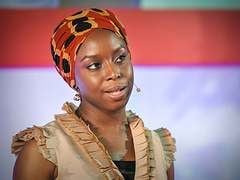 I’m reminded of a TED talk by Nigerian novelist Chimamanda Ngozi Adichie: “The consequence of the single story is this—that it robs people of dignity.”
I’m reminded of a TED talk by Nigerian novelist Chimamanda Ngozi Adichie: “The consequence of the single story is this—that it robs people of dignity.”
Slavery can’t be the only story our students—regardless of color, ethnicity, or cultural background—hear about the history of Blacks in America. The Holocaust can’t be the only story they hear about Jews. Terrorism can’t be the only story they hear about Muslims. Pearl Harbor can’t be the only story they hear about Asians. Undocumented workers can’t be the only story they hear about Latinx. And Thanksgiving can’t be the only story they hear about our Native Nations.
When developing Library Lessons, I ask myself:
- How can I make this lesson culturally responsive for all my students?
- Can I choose a wider range of resources?
- Does the activity allow for the cultural learning styles of all students?
- Am I phrasing my topic in a culturally sensitive manner?
- Is this lesson building respect for all students?
A RESPECTFUL SCHOOL LIBRARY PROGRAM
With the divisiveness that currently pervades our society, it’s imperative for School Librarians to build respect for other cultures/races/ethnicities in every facet of our School Library Program. We can’t just promote heritage celebrations for a month. We must work diligently, and throughout the school year, to be culturally responsive with ourselves, our library collection, and our Library Lessons. It’s the only way our students can learn to love themselves.



Bravo! Your commentary is an excellent perspective that, in my opinion, should be required reading in any LIS Collection Development course. Before retirement, I taught LIS courses in a master’s LIS program for 10 years and was a big proponent of pop-up displays that changed frequently. The recurring criteria was to NOT use a topic like Black History or Women’s History but to use themes such as Bravery, Risk-Taking, Perseverance, or Overcoming the Odds and include diverse cultures/races/ethnicities. Although harder to create because a simple catalog search wasn’t likely to offer much as a subject heading, the resulting displays were much more inclusive and much more culturally responsive. So, even if a student did not check out a book after looking at the display, perhaps they could infer that “no man is an island.” There is an interconnectedness we can recognize and honor.